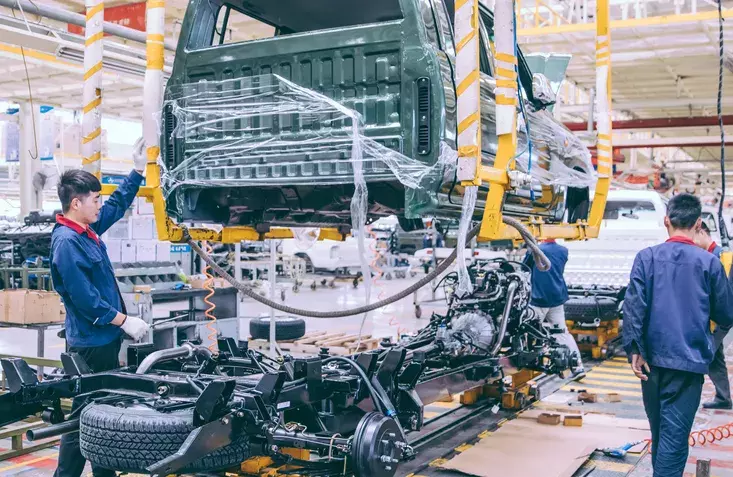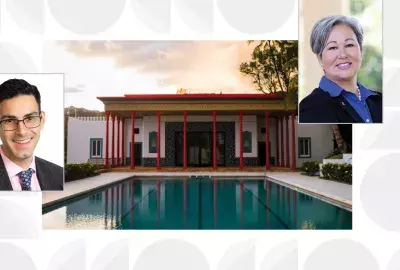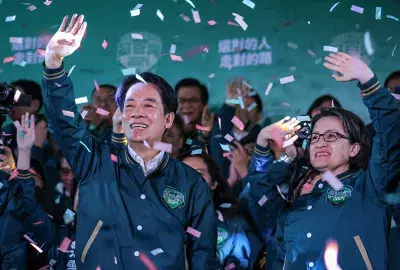Error message

By Boy Lüthje
HONOLULU (6 April 2020)—The development of electric and self-driving vehicles is bringing on a massive restructuring of the global automotive industry. Emerging forms of new and shared mobility undermine the very model of private car ownership that has underpinned the automotive industry since the days of Henry Ford.
China is at the center of this revolutionary change. The build-up of state-of-the-art production capacity during the past decade has made China the largest producer and consumer of cars in the world. In 2005, the Chinese market accounted for 8.7 percent of new car sales globally: In 2017, China’s market share peaked at 30.2 percent. This meteoric expansion has provided a much-needed safety valve for overcapacity in the car industry elsewhere in the world.
Today, this period of rapid growth may be coming to an end. Mass car ownership remains restricted to the urban middle classes in China, consumers with incomes well above the level of most manufacturing and agricultural workers. New car sales appear to be slowing down. Government efforts to prop up the industry by extensive investment in highways and other infrastructure, subsidized fuel prices, and massive financial subsidies to car buyers may have reached their limits.
Current changes in the car industry do not merely represent a new technological paradigm. They constitute a comprehensive rupture in the corporate structures that were established with the introduction of mass production in the 1920s.
What new technologies are disrupting the automotive industry?
Four new technologies are disrupting the automotive industry in China and around the world:
- Electric vehicles: Electrification promises to reduce carbon emissions, but it renders much of the know-how and skills of established carmakers obsolete. It also reduces the labor content of car making by as much as 50 percent.
- Self-driving systems: Digital driving brings in the big IT players with their models of innovation and their financial power. This development implies a shift of market control from brand-name manufacturers to providers of digital driving systems and their partners in big data and artificial intelligence.
- Mobility networks: Digital driving is shifting the model of private car ownership toward car sharing and other mobility networks. This shift moves the center of innovation to the networks and applications that enable the shared use of cars, comparable to other mass-production industries with “platform-based” models of innovation, such as cell phones.
- Digital manufacturing: Digital manufacturing opens up new possibilities for flexible specialization that can combine high-volume production with customer-specific design, potentially rendering the traditional model of mass manufacturing obsolete and undermining the dominance of brand-name firms.
Current conditions in the automotive industry can be compared to the traditional IT and electronics industry on the eve of the personal computer and Internet “revolutions.” In the late 1980s, new companies not only pioneered sweepingly disruptive technologies, but they brought in a whole new model of industrial organization based on vertical disintegration and specialization. Brand-name control moved from final assemblers such as IBM to component suppliers, and production was shifted to contract manufacturers such as Flextronics and Foxconn that created massive manufacturing sites in Mexico, Eastern Europe, Southeast Asia, and China.
How will China respond?
Today, China’s automobile industry is split into a capital-intensive “high end,” comprised of joint ventures between Chinese state-owned enterprises and multinational brands, and a “low end,” comprised of system suppliers and parts manufacturers. The top layers of these production networks—assembly of cars and some strategic components (engines in particular)—are controlled by the joint ventures. The middle and lower tiers are mostly owned by private local, foreign, and overseas-Chinese investors. In addition, a number of smaller carmakers under private or “hybrid” ownership are challenging the large state-owned enterprises in specific markets. These smaller indigenous Chinese carmakers are either owned by local governments of cities or townships or by private investors, often with some involvement from local governments.
This complicated structure is producing a bi-furcated regime, with high profits at the top of the supply chain and massive pressure on small companies at the bottom. Within this general structure, specific forms of integration are highly unstable and changing rapidly.
Serious doubts have been voiced about the efficiency of China’s current framework. For one thing, the growing electric vehicle industry is evolving in a modularized pattern, composed of sub-industries that provide the major components and systems. This changing landscape of production may trigger a significant decentralization of the Chinese car industry after years of government policies to consolidate the sector under joint ventures with state-owned enterprises.
The Chinese government has responded with policies to speed up the development of electric vehicles and new mobility systems in a drive to leapfrog industrialized countries in technology and innovation networks. Production of specialty cars, delivery trucks, buses, and public-transport systems provides a major opportunity for growth. New regional centers of production and innovation have come to the fore, including Shenzhen, the Pearl-River Delta, Hangzhou, and Fujian Province.
Government-industry relations in these new locations are essentially different from those in the traditional centers of the auto industry. The new centers are governed by looser regulations, with arms-length relationships between local governments and privately owned firms. Government support can be critical, however. Shenzhen, for example, started early to build charging stations for electric vehicles and rapidly expanded the use of locally made electric vehicles in public transportation. The city now has the most complete infrastructure of this kind in China and is actively developing integrated supply chains for the production of electric vehicles and the batteries that power them.
These changes have a potentially huge impact on workers. In the traditional centers of car manufacturing, massive workforce reductions and plant closures are imminent. The smaller independent companies now coming to the fore pay much lower wages—about US$4.00–4.50 per hour compared to US$9.00 per hour at the top joint ventures. Production workers in these smaller companies, many of them migrants, are forced to work overtime just to earn a living wage.
Overall, two scenarios can be envisaged. On the one hand, today’s mass-production models of global carmakers could simply be refurbished. This strategy underlies the present drive of traditional carmakers to “electrify” their products and to integrate the large-scale manufacturing of electric vehicles into their existing networks of production. Alternatively, a more disintegrated system could emerge similar to the electronics industry, consisting of layers of specialized high-volume production separated between brand-name carmakers, providers of core components, and contract manufacturers.
The challenge for the Chinese government is to downsize overcapacity in the traditional car sector while simultaneously creating new, complex networks of production and innovation under a scattered structure—a structure characterized by competing modes of regulation and significant potential for conflicts with labor.
###
This East-West Wire is based on Going digital, going green: Changing value chains and regimes of accumulation in the automotive industry in China by Boy Lüthje (2019), East-West Center Working Papers: Innovation and Economic Growth Series No. 15, Honolulu: East-West Center.
Download a pdf version of this Wire article.
Boy Lüthje is the Volkswagen Endowed Chair of Industrial Relations and Social Development at Sun Yat-sen University and a Visiting Scholar at the East-West Center. He can be reached at [email protected].
The views expressed do not necessarily reflect the policy or position of the East-West Center or of any other organization.
The East-West Wire is a news, commentary, and analysis service provided by the East-West Center in Honolulu. All or any part of the Wire content may be used by media with attribution to the East-West Center or the person quoted. To receive Wire articles via email, subscribe here. For links to all East-West Center media programs, fellowships and services, see EastWestCenter.org/Journalists.
The full list of East-West Wires produced by the Research Program is available on the East-West Center website at EastWestCenter.org/Research-Wire. For more on the East-West Center Research Program, see EastWestCenter.org/Research.
The East-West Center promotes better relations and understanding among the people and nations of the United States, Asia, and the Pacific through cooperative study, research, and dialogue.
Series editors:
Derek Ferrar
[email protected]
Sidney B. Westley
[email protected]
Photo: Automobile factory welding assembly line, Beijing, China. Credit: Chalffy, Getty Images.
By Boy Lüthje
HONOLULU (6 April 2020)—The development of electric and self-driving vehicles is bringing on a massive restructuring of the global automotive industry. Emerging forms of new and shared mobility undermine the very model of private car ownership that has underpinned the automotive industry since the days of Henry Ford.
China is at the center of this revolutionary change. The build-up of state-of-the-art production capacity during the past decade has made China the largest producer and consumer of cars in the world. In 2005, the Chinese market accounted for 8.7 percent of new car sales globally: In 2017, China’s market share peaked at 30.2 percent. This meteoric expansion has provided a much-needed safety valve for overcapacity in the car industry elsewhere in the world.
Today, this period of rapid growth may be coming to an end. Mass car ownership remains restricted to the urban middle classes in China, consumers with incomes well above the level of most manufacturing and agricultural workers. New car sales appear to be slowing down. Government efforts to prop up the industry by extensive investment in highways and other infrastructure, subsidized fuel prices, and massive financial subsidies to car buyers may have reached their limits.
Current changes in the car industry do not merely represent a new technological paradigm. They constitute a comprehensive rupture in the corporate structures that were established with the introduction of mass production in the 1920s.
What new technologies are disrupting the automotive industry?
Four new technologies are disrupting the automotive industry in China and around the world:
- Electric vehicles: Electrification promises to reduce carbon emissions, but it renders much of the know-how and skills of established carmakers obsolete. It also reduces the labor content of car making by as much as 50 percent.
- Self-driving systems: Digital driving brings in the big IT players with their models of innovation and their financial power. This development implies a shift of market control from brand-name manufacturers to providers of digital driving systems and their partners in big data and artificial intelligence.
- Mobility networks: Digital driving is shifting the model of private car ownership toward car sharing and other mobility networks. This shift moves the center of innovation to the networks and applications that enable the shared use of cars, comparable to other mass-production industries with “platform-based” models of innovation, such as cell phones.
- Digital manufacturing: Digital manufacturing opens up new possibilities for flexible specialization that can combine high-volume production with customer-specific design, potentially rendering the traditional model of mass manufacturing obsolete and undermining the dominance of brand-name firms.
Current conditions in the automotive industry can be compared to the traditional IT and electronics industry on the eve of the personal computer and Internet “revolutions.” In the late 1980s, new companies not only pioneered sweepingly disruptive technologies, but they brought in a whole new model of industrial organization based on vertical disintegration and specialization. Brand-name control moved from final assemblers such as IBM to component suppliers, and production was shifted to contract manufacturers such as Flextronics and Foxconn that created massive manufacturing sites in Mexico, Eastern Europe, Southeast Asia, and China.
How will China respond?
Today, China’s automobile industry is split into a capital-intensive “high end,” comprised of joint ventures between Chinese state-owned enterprises and multinational brands, and a “low end,” comprised of system suppliers and parts manufacturers. The top layers of these production networks—assembly of cars and some strategic components (engines in particular)—are controlled by the joint ventures. The middle and lower tiers are mostly owned by private local, foreign, and overseas-Chinese investors. In addition, a number of smaller carmakers under private or “hybrid” ownership are challenging the large state-owned enterprises in specific markets. These smaller indigenous Chinese carmakers are either owned by local governments of cities or townships or by private investors, often with some involvement from local governments.
This complicated structure is producing a bi-furcated regime, with high profits at the top of the supply chain and massive pressure on small companies at the bottom. Within this general structure, specific forms of integration are highly unstable and changing rapidly.
Serious doubts have been voiced about the efficiency of China’s current framework. For one thing, the growing electric vehicle industry is evolving in a modularized pattern, composed of sub-industries that provide the major components and systems. This changing landscape of production may trigger a significant decentralization of the Chinese car industry after years of government policies to consolidate the sector under joint ventures with state-owned enterprises.
The Chinese government has responded with policies to speed up the development of electric vehicles and new mobility systems in a drive to leapfrog industrialized countries in technology and innovation networks. Production of specialty cars, delivery trucks, buses, and public-transport systems provides a major opportunity for growth. New regional centers of production and innovation have come to the fore, including Shenzhen, the Pearl-River Delta, Hangzhou, and Fujian Province.
Government-industry relations in these new locations are essentially different from those in the traditional centers of the auto industry. The new centers are governed by looser regulations, with arms-length relationships between local governments and privately owned firms. Government support can be critical, however. Shenzhen, for example, started early to build charging stations for electric vehicles and rapidly expanded the use of locally made electric vehicles in public transportation. The city now has the most complete infrastructure of this kind in China and is actively developing integrated supply chains for the production of electric vehicles and the batteries that power them.
These changes have a potentially huge impact on workers. In the traditional centers of car manufacturing, massive workforce reductions and plant closures are imminent. The smaller independent companies now coming to the fore pay much lower wages—about US$4.00–4.50 per hour compared to US$9.00 per hour at the top joint ventures. Production workers in these smaller companies, many of them migrants, are forced to work overtime just to earn a living wage.
Overall, two scenarios can be envisaged. On the one hand, today’s mass-production models of global carmakers could simply be refurbished. This strategy underlies the present drive of traditional carmakers to “electrify” their products and to integrate the large-scale manufacturing of electric vehicles into their existing networks of production. Alternatively, a more disintegrated system could emerge similar to the electronics industry, consisting of layers of specialized high-volume production separated between brand-name carmakers, providers of core components, and contract manufacturers.
The challenge for the Chinese government is to downsize overcapacity in the traditional car sector while simultaneously creating new, complex networks of production and innovation under a scattered structure—a structure characterized by competing modes of regulation and significant potential for conflicts with labor.
###
This East-West Wire is based on Going digital, going green: Changing value chains and regimes of accumulation in the automotive industry in China by Boy Lüthje (2019), East-West Center Working Papers: Innovation and Economic Growth Series No. 15, Honolulu: East-West Center.
Download a pdf version of this Wire article.
Boy Lüthje is the Volkswagen Endowed Chair of Industrial Relations and Social Development at Sun Yat-sen University and a Visiting Scholar at the East-West Center. He can be reached at [email protected].
The views expressed do not necessarily reflect the policy or position of the East-West Center or of any other organization.
The East-West Wire is a news, commentary, and analysis service provided by the East-West Center in Honolulu. All or any part of the Wire content may be used by media with attribution to the East-West Center or the person quoted. To receive Wire articles via email, subscribe here. For links to all East-West Center media programs, fellowships and services, see EastWestCenter.org/Journalists.
The full list of East-West Wires produced by the Research Program is available on the East-West Center website at EastWestCenter.org/Research-Wire. For more on the East-West Center Research Program, see EastWestCenter.org/Research.
The East-West Center promotes better relations and understanding among the people and nations of the United States, Asia, and the Pacific through cooperative study, research, and dialogue.
Series editors:
Derek Ferrar
[email protected]
Sidney B. Westley
[email protected]
Photo: Automobile factory welding assembly line, Beijing, China. Credit: Chalffy, Getty Images.
East-West Wire
News, Commentary, and Analysis
The East-West Wire is a news, commentary, and analysis service provided by the East-West Center in Honolulu. Any part or all of the Wire content may be used by media with attribution to the East-West Center or the person quoted. To receive East-West Center Wire media releases via email, subscribe here.
For links to all East-West Center media programs, fellowships and services, see www.eastwestcenter.org/journalists.







